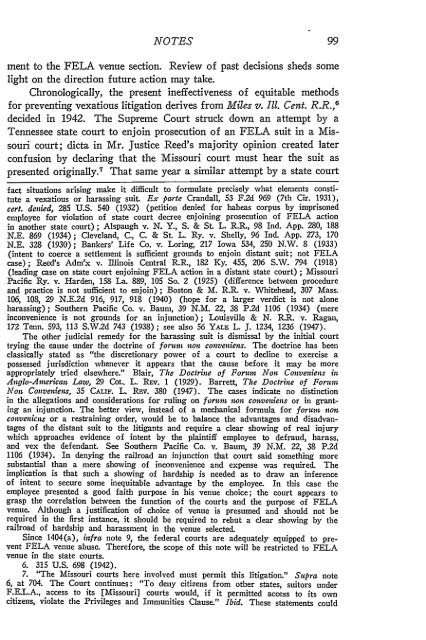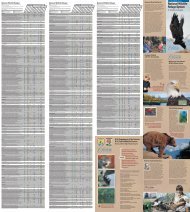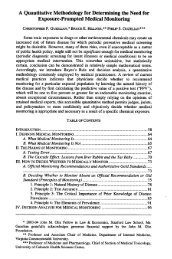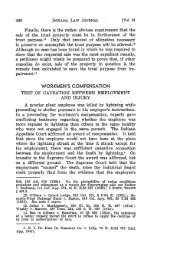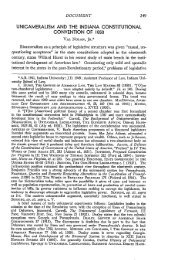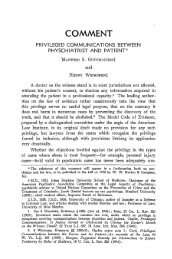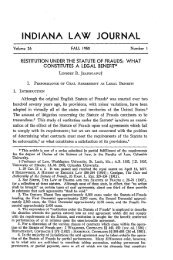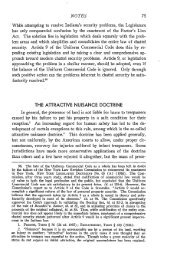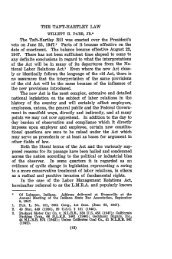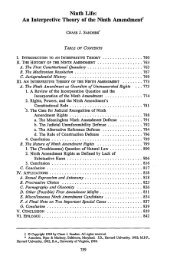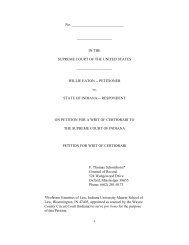fela venue abuse: necessity for congressional amendment
fela venue abuse: necessity for congressional amendment
fela venue abuse: necessity for congressional amendment
You also want an ePaper? Increase the reach of your titles
YUMPU automatically turns print PDFs into web optimized ePapers that Google loves.
NOTES<br />
ment to the FELA <strong>venue</strong> section. Review of past decisions sheds some<br />
light on the direction future action may take.<br />
Chronologically, the present ineffectiveness of equitable methods<br />
<strong>for</strong> preventing vexatious litigation derives from Miles v. Ill. Cent. R.R., 6<br />
decided in 1942. The Supreme Court struck down an attempt by a<br />
Tennessee state court to enjoin prosecution of an FELA suit in a Missouri<br />
court; dicta in Mr. Justice Reed's majority opinion created later<br />
confusion by declaring that the Missouri court must hear the suit as<br />
presented originally. 7 That same year a similar attempt by a state court<br />
fact situations arising make it difficult to <strong>for</strong>mulate precisely what elements constitute<br />
a vexatious or harassing suit. Ex parte Crandall, 53 F.2d 969 (7th Cir. 1931),<br />
cert. denied, 285 U.S. 540 (1932) (petition denied <strong>for</strong> habeas corpus by imprisoned<br />
employee <strong>for</strong> violation of state court decree enjoining prosecution of FELA action<br />
in another state court); Alspaugh v. N. Y., S. & St. L. R.R., 98 Ind. App. 280, 188<br />
N.E. 869 (1934); Cleveland, C., C. & St. L. Ry. v. Shelly, 96 Ind. App. 273, 170<br />
N.E. 328 (1930); Bankers' Life Co. v. Loring, 217 Iowa 534, 250 N.W. 8 (1933)<br />
(intent to coerce a settlement is sufficient grounds to enjoin distant suit; not FELA<br />
case) ; Reed's Adm'x v. Illinois Central R.M, 182 Ky. 455, 206 S.W. 794 (1918)<br />
(leading case on state court enjoining FELA action in a distant state court) ; Missouri<br />
Pacific Ry. v. Harden, 158 La. 889, 105 So. 2 (1925) (difference between procedure<br />
and practice is not sufficient to enjoin); Boston & M. MR. v. Whitehead, 307 Mass.<br />
106, 108, 29 N.E.2d 916, 917, 918 (1940) (hope <strong>for</strong> a larger verdict is not alone<br />
harassing); Southern Pacific Co. v. Baum, 39 N.M. 22, 38 P.2d 1106 (1934) (mere<br />
inconvenience is not grounds <strong>for</strong> an injunction); Louisville & N. RR. v. Ragan,<br />
172 Tenn. 593, 113 S.W.2d 743 (1938); see also 56 YALE L. J. 1234, 1236 (1947).<br />
The other judicial remedy <strong>for</strong> the harassing suit is dismissal by the initial court<br />
trying the cause under the doctrine of <strong>for</strong>um non conveniens. The doctrine has been<br />
classically stated as "the discretionary power of a court to decline to exercise a<br />
possessed jurisdiction whenever it appears that the cause be<strong>for</strong>e it may be more<br />
appropriately tried elsewhere." Blair, The Doctrine of Forum Non Conveniens in<br />
Anglo-American Law, 29 CoL. L. REv. 1 (1929). Barrett, The Doctrine of Forum<br />
Non Conveniens, 35 CALIF. L. Rnv. 380 (1947). The cases indicate no distinction<br />
in the allegations and considerations <strong>for</strong> ruling on <strong>for</strong>um iwn conveniens or in granting<br />
an injunction. The better view, instead of a mechanical <strong>for</strong>mula <strong>for</strong> <strong>for</strong>um non<br />
conveniens or a restraining order, would be to balance the advantages and disadvantages<br />
of the distant suit to the litigants and require a clear showing of real injury<br />
which approaches evidence of intent by the plaintiff employee to defraud, harass,<br />
and vex the defendant. See Southern Pacific Co. v. Baum, 39 N.M. 22, 38 P.2d<br />
1106 (1934). In denying the railroad an injunction that court said something more<br />
substantial than a mere showing of inconvenience and expense was required. The<br />
implication is that such a showing of hardship is needed as to draw an inference<br />
of iftent to secure some inequitable advantage by the employee. In this case the<br />
employee presented a good faith purpose in his <strong>venue</strong> choice; the court appears to<br />
grasp the correlation between the function of the courts and the purpose of FELA<br />
<strong>venue</strong>. Although a justification of choice of <strong>venue</strong> is presumed and should not be<br />
required in the first instance, it should be required to rebut a clear showing by the<br />
railroad of hardship and harassment in the <strong>venue</strong> selected.<br />
Since 1404(a), infra note 9, the federal courts are adequately equipped to prevent<br />
FELA <strong>venue</strong> <strong>abuse</strong>. There<strong>for</strong>e, the scope of this note will be restricted to FELA<br />
<strong>venue</strong> in the state courts.<br />
6. 315 U.S. 698 (1942).<br />
7. "The Missouri courts here involved must permit this litigation." Supra note<br />
6, at 704. The Court continues: "To deny citizens from other states, suitors under<br />
F.E.L.A., access to its [Missouri] courts would, if it permitted access to its own<br />
citizens, violate the Privileges and Immunities Clause." Ibid. These statements could


